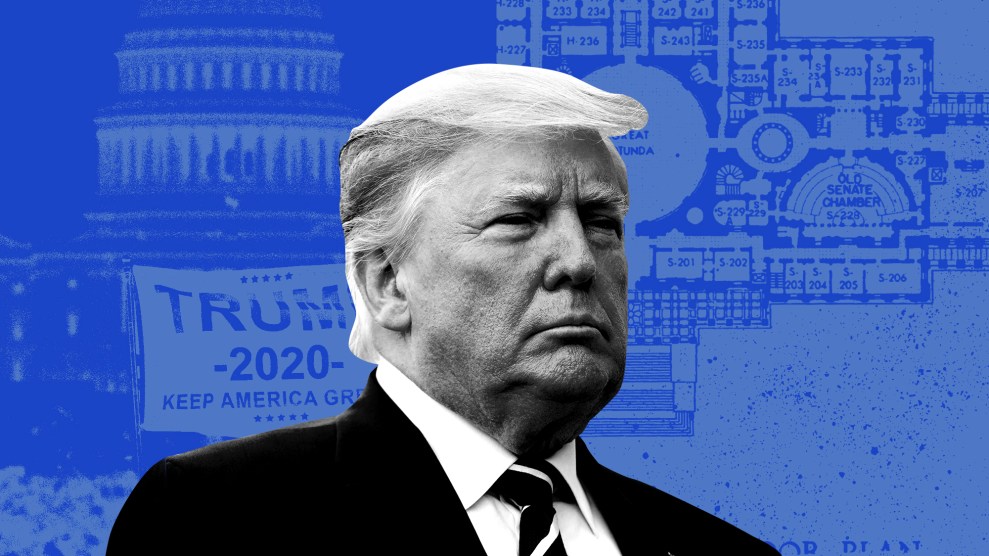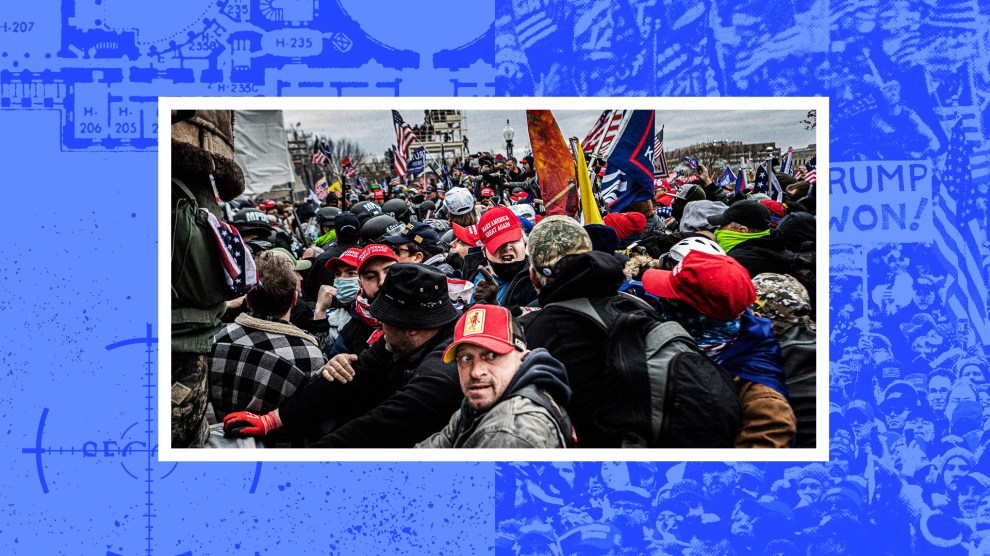
Mother Jones; zz/KGC-375/STAR MAX/IPx/AP
After 18 months of investigation and hearings, the House January 6 committee has confirmed the obvious: “The central cause of January 6th was one man, former President Donald Trump, who many others followed. None of the events of January 6th would have happened without him.” The committee cited this conclusion in a 161-page introduction to its forthcoming final report that was released on Monday. The full report is expected to be made public on Wednesday.
The committee had something of an odd assignment: prove what was already proved. Trump’s disinformation crusade that advanced the lie that the 2020 election was fraudulent and his incitement of the insurrectionist violence both happened in plain sight. Yet the introduction notes, “Millions of Americans believed that Trump was telling the truth on election night—that Trump actually had proof the election was stolen and that the ongoing counting of votes was an act of fraud.” These Americans continued to believe Trump in the weeks after Election Day, and the committee notes it initially faced the challenge that “millions of Americans still lack the information necessary to understand and evaluate what President Trump has told them about the election.”
How to bring the light to these people? How to forge a national consensus about Trump’s efforts to overturn the election that led to a seditious act of domestic terrorism? In this document, the committee shows that it thoroughly investigated and chronicled these events, and it explains its reasons for sending to the Justice Department a criminal referral of Trump on various charges: for obstructing an official proceeding (the counting of the electoral votes), for conspiring to defraud the United States, for conspiring to make false statements, and for inciting insurrection. But in the face of an unrelenting propaganda campaign from Trump and the right’s attempts to dismiss or downplay January 6, to diminish the work of the committee, to distract from Trump’s various plots to reverse the election, and to keep his Big Lie alive, it’s unclear how far the committee has succeeded in enlightening those Americans who bought Trump’s con.
Judging from the introduction, the final report should do the trick for anyone who does not maintain a cult-like loyalty to Trump and his falsehoods. This preliminary portion is a thorough and easy-to-read document that effectively summarizes the committee’s hearings and investigative digging and that chronicles all the elements of Trump’s plot to destroy American democracy.
As the introduction notes, Trump, beginning on election night, purposefully disseminated “false allegations of fraud…to aid his effort to overturn the election” (and to solicit what would end up being about $250 million in political contributions). Even though he was repeatedly informed by senior advisers that there was no legitimate basis for alleging fraud, he refused to accept the results and “plotted to overturn the election outcome.” He “sought to corrupt the U.S. Department of Justice by attempting to enlist Department officials to make purposely false statements and thereby aid his effort to overturn the Presidential election.” (And when that effort failed, he tried to install as attorney general a Big Lie crony who intended to declare the election fraudulent and pressure officials in Georgia to renounce the state’s election results.) Without “any evidentiary basis and contrary to State and Federal law,” Trump himself “unlawfully pressured State officials and legislators to change the results.”
And there’s more: Trump “oversaw an effort to obtain and transmit false electoral certificates to Congress and the National Archives.” He pressed members of Congress “to object to valid slates of electors.” He “purposely verified false information filed in federal court” to support bogus lawsuits alleging election fraud. He then “corruptly pressured Vice President Mike Pence to refuse to count electoral votes” during Congress’ joint session on January 6. Finally, he “summoned tens of thousands of supporters to Washington for January 6th,” and though he knew some of these Trumpists were angry and armed, he instructed them to march to the Capitol. Once the violent attack was underway, he posted a tweet condemning Pence that further inflamed the mob. And while the riot proceeded, Trump “refused repeated requests…to instruct his violent supporters to disperse and leave the Capitol.” Instead, he “watched the violent attack unfold on television.”
The committee sums up: “Each of these actions by Donald Trump was taken in support of a multi-part conspiracy to overturn the lawful results of the 2020 Presidential election.”
It’s a damning indictment of a man who had once sworn to uphold and defend the Constitution. Even though this is only an introductory document, it is loaded with details. It shows that many of his closest advisers repeatedly told him that there was no significant fraud and that his assorted schemes to stay in power were wrong or illegal—and Trump disregarded all this. Instead, he listened to a band of wackos led by lawyers Rudy Giuliani and Sidney Powell. (At one point in the post-election period, Bill Stepien, the Trump campaign manager, felt compelled to lock Giuliani out of Stepien’s office.) Even after John Eastman, the right-wing legal scholar who had promoted the idea that Pence could block the electoral vote certification, told Trump on January 5 that his proposal would violate the law, Trump proceeded with this scheme: “Trump nevertheless continued to exert immense pressure on Pence to refuse to count electoral votes.” The report confirms that Trump called Pence a “pussy” for refusing to do so. The committee notes that on January 6, as his marauders were ransacking the Capitol and blocking the peaceful transfer of power, Trump never ordered the deployment of the National Guard troops nor did he have a single phone call with any law enforcement or national security agency.
It wasn’t Trump alone. The report covers the various co-conspirators. Republican Party chair Ronna McDaniel helped with the fake electors scheme. As did the offices of Sen. Ron Johnson (R-Wis.) and Rep. Mike Kelly (R-Pa.). Numerous GOP members of Congress were involved in different facets of Trump’s various plots, including Rep. Scott Perry of Pennsylvania, Jim Jordan of Ohio, and Andy Biggs of Arizona. The committee has referred Perry, Jordan, Biggs, and Rep. Kevin McCarthy (R-Calif.) “for sanction by the House Ethics Committee for failure to comply with subpoenas” to testify before the committee. The committee points out that Mark Meadows, in his memoir, published a false account of January 6 (as I’ve noted).
The report documents that the extremists who assaulted the Capitol had been motivated and inspired by Trump’s lies: “President Trump’s supporters believed the election was stolen because they listened to his words, and they knew what he had called them to do; stop the certification of the electoral count.”
The committee also characterizes that horrific day as an intelligence failure: “[D]ocumentation received by the Committee from the Secret Service demonstrates a growing number of warnings both that January 6th was likely to be violent, and specifically that the Capitol would likely be the target, including intelligence directly regarding the Proud Boys and Oath Keepers militia groups.” Other agencies missed obvious signs. The problem was that the intelligence collected suggesting violence was possible—or likely—did not reach the appropriate authorities. But the Trump White House was in the know: “After President Trump’s signal, his supporters did not hide their plans for violence at the Capitol, and those threats made their way to national and local law enforcement agencies. As described in this report, the intelligence agencies did detect this planning, and they shared it with the White House and with the U.S. Secret Service.”
According to the committee report, days ahead of January 6 Trump planned to issue what would seem to be a spontaneous call to his supporters to march on the Capitol. (One piece of evidence for this: a text sent to Mike Lindell, the My Pillow guy and chief Trump conspiracy-monger.) And the committee notes that when Trump was blocked by the Secret Service from accompanying the crowd, he was, according to the testimony of several witnesses, “irate,” “furious,” “insistent,” “profane,” and “heated.” (The introduction doesn’t fully resolve the question of whether Trump got into a physical altercation with a Secret Service agent who refused to drive him toward Capitol Hill.)
Perhaps the most disturbing portion of this document is the account of Trump’s actions—or inaction—while the January 6 riot ensued. From a distance, he worked the crowd up with his tweet about Pence and he refused entreaties from aides, family members, and others to instruct the rioters to leave the Capitol. According to the report, at some point Ivanka Trump “rushed down” to see Trump in the Oval Office dining room to “persuade her father to do the right thing… Although no one could convince President Trump to call for the violent rioters to leave the Capitol, Ivanka persuaded President Trump that a tweet could be issued to discourage violence against the police.” (The committee, in this report, says Ivanka was not “forthcoming” in her testimony.)
Curiously, the committee found a lack of White House records for that afternoon:
No photographs exist of the President for the remainder of the afternoon until after 4 p.m. President Trump appears to have instructed that the White House photographer was not to take any photographs. The Select Committee also was unable to locate any official records of President Trump’s telephone calls that afternoon. And the President’s official Daily Diary contains no information for this afternoon between the hours of 1:19 p.m. and 4:03 p.m., at the height of the worst attack on the seat of the United States Congress in over two centuries.
But Trump, according to his personal assistant, was placing “lots of calls” during that stretch.
In the committee’s account, Trump on January 6 never displayed concern about the violence or any remorse:
At 6:27 p.m., President Trump retired to his residence for the night. As he did, he had one final comment to an employee who accompanied him to the residence. The one takeaway that the President expressed in that moment, following a horrific afternoon of violence and the worst attack against the U.S. Capitol building in over two centuries, was this: “Mike Pence let me down.”
This introduction indicates the final report will be thousands of pages. It will thoroughly document a day of infamy and a multi-level conspiracy mounted by a president to subvert the Constitution and grab the power of a tyrant. This truth may be too difficult for Trump and his followers to handle. But for the rest of the country—and for posterity—the committee has established a record of this assault on the nation’s foundation. With this report, an important mission has been accomplished.
In testimony to the committee, Hope Hicks, a longtime Trump aide, recalled that when she told Trump during the post-election period that she believed his charges of fraud were “damaging his legacy,” Trump replied, “Nobody will care about my legacy if I lose.” That’s not true. The committee’s report seals what is now the most significant aspect of his legacy: Trump tried to illegally break the republic, and, fortunately, he failed.












